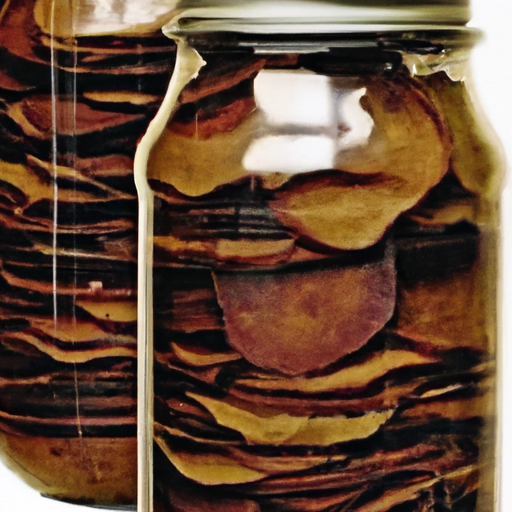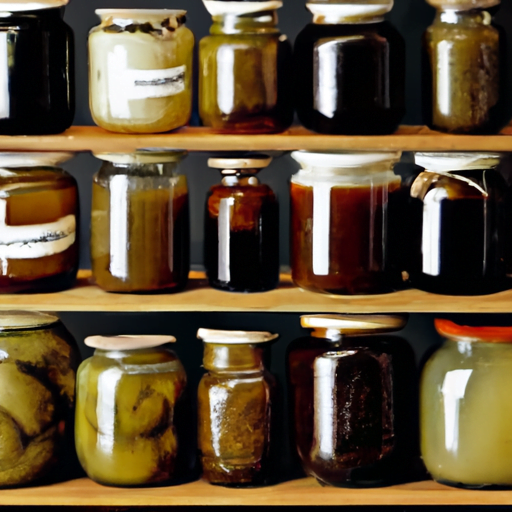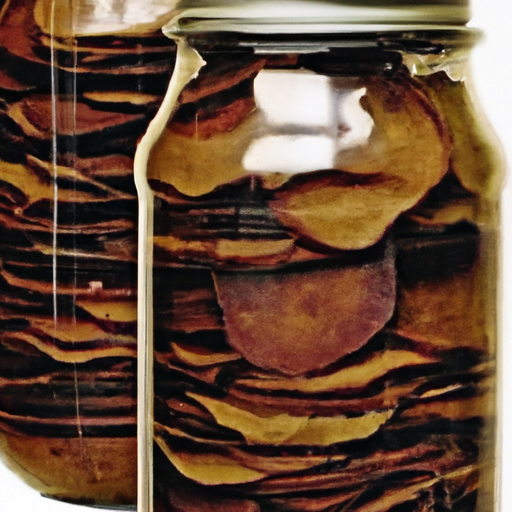Hey there! Have you ever wondered how people preserved their food back in the day, before refrigerators and fancy food storage techniques? Well, you’re in for a treat because today we’re going to dive into the fascinating world of the oldest food preservation techniques!
Let’s start off by talking about off grid living. Picture this: you’re living in a secluded cabin in the wilderness, surrounded by nature’s bounty. No grocery stores nearby, but plenty of fresh ingredients. How do you make sure that all that food doesn’t go to waste? That’s where food preservation techniques come in! People have been coming up with creative ways to make their food last longer for centuries, and some of these techniques are still used today.
Now, let’s get to the juicy part – the world’s oldest food preservative. Can you guess what it is? Drumroll, please… it’s salt! Yes, good old salt has been used for thousands of years to preserve food. Have you ever noticed that most of your favorite preserved goodies, like jerky or pickles, have a salty taste? That’s because salt not only adds flavor, but also draws out the moisture from the food, creating an environment where bacteria can’t thrive.
There’s so much more to learn about the oldest food preservation techniques and all the amazing ways humans have been able to make their food last longer. From smoking and drying to fermenting and pickling, these techniques have stood the test of time. So, if you’re curious to explore the ancient art of preserving food, stay tuned for more in our upcoming article!

Exploring the Oldest Food Preservation Techniques
Food preservation has been a vital practice throughout human history. As our ancestors discovered the importance of storing and preserving food, they developed various techniques to ensure their survival during times of scarcity. Understanding the oldest food preservation techniques not only provides us with a glimpse into our rich culinary heritage but also sheds light on the ingenuity and resourcefulness of ancient civilizations.
Understanding the Need for Food Preservation
Before the advent of modern refrigeration and food processing techniques, our ancestors had to rely on their knowledge and creativity to preserve food for extended periods. Understanding the need for food preservation was essential since it allowed them to sustain themselves during periods of drought, famine, or long journeys. By preserving food, they ensured a constant supply of nourishment and avoided wastage.
The Evolution of Food Preservation Techniques
The evolution of food preservation techniques can be traced back to ancient times. Early civilizations, such as the Egyptians, Mesopotamians, and Greeks, had a profound understanding of the importance of prolonging the shelf life of food. They developed numerous techniques that are still employed today, albeit in modernized forms.
The Significance of Preserving Food in Ancient Times
Ancient civilizations placed great emphasis on food preservation due to the perishable nature of certain food items and the necessity of building reserves. These preserved foods were not only used to sustain individuals during times of scarcity but also played significant roles in trade, exploration, and cultural practices.
Exploring Ancient Food Preservation Techniques
Salt Curing: A Time-Honored Method
Salt curing is one of the oldest methods of preserving food, dating back thousands of years. This technique involves rubbing salt onto meat, fish, or vegetables, which draws out moisture and inhibits the growth of bacteria. The salt acts as a natural preservative, transforming perishable items into long-lasting provisions. Salt-cured foods were particularly valuable in ancient times, as they could withstand long journeys and provide sustenance for extended periods.
Drying: A Natural Way to Preserve Food
Drying is another ancient method of food preservation that is still widely practiced today. By removing moisture from food, the growth of microorganisms that cause spoilage is inhibited. Ancient civilizations utilized various drying techniques, such as sun drying and air drying. These techniques allowed them to preserve fruits, vegetables, and meat without the need for refrigeration. Dried foods not only provided sustenance during harsh winters or travels but also served as a nutritious source of food when fresh produce was scarce.
Fermentation: Harnessing the Power of Microorganisms
Fermentation is a method of food preservation that harnesses the power of microorganisms to prolong the shelf life of perishable food items. Ancient civilizations discovered that certain microorganisms could convert sugars into alcohol or organic acids, creating an environment that inhibits the growth of harmful bacteria. This technique was widely used to preserve vegetables, fruits, and dairy products. Fermented foods not only offered longevity but also provided unique flavors and improved digestion.
Smoking: Adding Flavor and Preservation
Smoking is a preservation technique that has been practiced for centuries. The process involves exposing food, typically meat or fish, to smoke from burning wood or other plant materials. The smoke acts as a preservative by reducing the water content and inhibiting the growth of bacteria. Additionally, smoking imparts a distinct flavor to the food, enhancing its taste and prolonging its shelf life. Ancient civilizations relied on smoking to preserve meat and fish, ensuring their availability during times of scarcity.
Pickling: Preserving Through Vinegar and Brine
Pickling is a preservation method that involves immersing food items in a solution of vinegar, brine, or a combination of both. The acidic environment created by the vinegar or brine inhibits the growth of spoilage-causing microorganisms. Ancient civilizations used pickling to preserve a wide range of vegetables, fruits, and even meat. Pickled foods not only offered extended shelf life but also added tangy flavors to meals.
Historical Context of Food Preservation
Ancient Civilizations and Preservation Methods
Ancient civilizations across the globe developed their own unique food preservation techniques based on their geographical location, available resources, and cultural practices. Egyptians, for example, utilized techniques such as drying, salting, and pickling. The Mesopotamians relied heavily on fermentation and drying. Greeks adopted similar methods of preservation but also introduced techniques like marinating food in olive oil and wine. These preservation methods played vital roles in sustaining the population and facilitating trade among ancient civilizations.
From Icehouses to Cool Cellars: Early Refrigeration
In some regions with colder climates, early civilizations devised methods to preserve food by utilizing natural ice and cold temperatures. Icehouses, which were large buildings or underground chambers, were used to store ice throughout the year. The ice was harvested during winters and stored, providing a means to keep perishable food items cool during summer months. Later, cool cellars were built, which took advantage of natural cool temperatures found underground. These early refrigeration techniques allowed for the preservation of food in a pre-electricity era.
Root Cellars: Storing Produce for Winter
Root cellars emerged as a popular method of food preservation during the 17th and 18th centuries. These underground chambers provided a cool and humid environment that was ideal for storing root vegetables, fruits, and other produce during the winter months. The consistent temperature and humidity levels helped prolong the shelf life of fruits and vegetables, ensuring a steady supply of fresh food during the colder seasons.

Traditional Preservation Techniques Across Cultures
Sun-Drying: Staple Preservation Method in Hot Climates
Sun-drying is a traditional preservation method that has been used for centuries in regions with hot climates. Fruits, vegetables, grains, meat, and fish are spread out in the sun, allowing the intense heat to remove moisture from the food. Sun-drying not only acts as a preservation technique but also enhances the flavors of the food. This method is still widely practiced today, particularly in countries with tropical climates.
Curing with Spices and Herbs: Aromatic Preservation
In many cultures, the preservation of food is achieved through the use of various spices and herbs. These aromatic ingredients not only lend unique flavors to the preserved food but also possess antimicrobial properties that aid in preservation. Spices such as cinnamon, clove, and pepper, as well as herbs like thyme, oregano, and rosemary, have long been used to cure and preserve meat, fish, and even fruits.
Souring: Preserving with Fermented Ingredients
Souring, similar to fermentation, is a preservation technique that involves the use of acidic and fermented ingredients to extend the shelf life of food. Ancient civilizations employed this method by using ingredients like lemons, limes, tamarind, and vinegar. These souring agents not only preserved food but also added tangy flavors, making meals more enjoyable.
Sealing with Fat: Traditional Methods of Pemmican
Pemmican, a traditional food product developed by indigenous peoples such as Native Americans, played a crucial role in their survival for centuries. This preserved food consisted of dried meat, typically buffalo or venison, mixed with melted fat and sometimes berries. The fat acted as a sealant, preventing the growth of bacteria and extending the shelf life of the meat. Pemmican was lightweight, easy to transport, and provided energy-rich sustenance during long journeys or times of scarcity.
Preserving Foods through Fermentation
The Science of Fermentation
Fermentation is a natural metabolic process that utilizes microorganisms such as bacteria, yeasts, or molds to convert carbohydrates into alcohol, organic acids, or gases. This process not only preserves food but also alters its flavor, texture, and nutritional value. The release of acids and other compounds during fermentation creates an environment hostile to spoilage-causing microorganisms, allowing the food to be stored for longer periods without refrigeration.
Fermented Foods: Health Benefits and Culinary Traditions
Fermented foods have been consumed for centuries across various cultures due to their unique flavors and perceived health benefits. The fermentation process increases the bioavailability of nutrients, such as vitamins and minerals, and produces beneficial compounds like probiotics, which support gut health. Additionally, fermented foods often possess complex and tangy flavors, adding depth to culinary traditions.
Exploring Fermentation Techniques from Different Cultures
Fermentation techniques vary across cultures, reflecting the diverse culinary practices and regional preferences. Some well-known fermented foods include sauerkraut and kimchi (fermented cabbage), yogurt (fermented milk), miso and soy sauce (fermented soybeans), and pickles (fermented cucumbers). Each culture has its own unique fermentation practices, utilizing specific ingredients, time durations, and fermentation vessels.
Modern Techniques: Balancing Tradition and Convenience
Canning: The Invention that Revolutionized Food Preservation
Canning, also known as jar preservation, was a groundbreaking invention in the field of food preservation. Developed in the early 19th century, the process involves placing food in jars or cans, sealing them tightly, and heating them to destroy microorganisms. Canned foods can be stored for long periods without refrigeration, making them convenient for everyday use or emergencies. The invention of canning revolutionized the food industry, allowing for extended food storage and expanding culinary possibilities.
Freezing: Extending Shelf Life with Low Temperatures
Freezing is a modern food preservation technique that utilizes low temperatures to slow down or halt biological activity. By reducing the temperature below freezing, food items can be stored for long periods without significant changes in flavor, texture, or nutrition. Freezing allows for a wide variety of food items to be preserved, including fruits, vegetables, meat, seafood, and even prepared meals.
Vacuum Sealing: Eliminating Oxygen for Longevity
Vacuum sealing is a method that removes air from packages or containers before sealing, creating a vacuum environment. The absence of oxygen slows down the growth of spoilage-causing microorganisms, thus extending the shelf life of food. Vacuum-sealed items can be stored in a refrigerator or freezer and maintain their freshness for longer durations. This technique is commonly used for preserving perishable items such as cheese, deli meats, and leftovers.
High-Pressure Processing: A Modern Take on Pasteurization
High-pressure processing (HPP) is a technique that utilizes high levels of pressure to destroy harmful bacteria and extend the shelf life of food. This non-thermal preservation method maintains the quality, flavor, and nutritional value of the food while ensuring safety. HPP is commonly used for fresh juices, sauces, and ready-to-eat meals, offering convenience without compromising on taste or health.
Preservation Challenges in the Digital Age
Preserving Traditional Knowledge and Techniques
While modern food preservation techniques have made our lives easier, there is a concern about preserving traditional knowledge and techniques. Traditional preservation methods are deeply rooted in cultural heritage and play a significant role in culinary practices. It is crucial to safeguard this knowledge and ensure that future generations have access to these time-honored techniques.
Impact of Modern Food Production on Preservation
The industrialization of food production has led to changes in preservation practices. Mass production, long-distance transportation, and the use of chemical preservatives often prioritize convenience and profit over traditional preservation methods. As a result, the connection to our culinary heritage and the unique flavors associated with traditional preservation techniques are gradually being lost.
Climate Change and its Effects on Traditional Preservation
Climate change poses additional challenges to traditional food preservation techniques. Rising temperatures, changes in precipitation patterns, and natural disasters can impact the availability of resources necessary for traditional preservation methods. As our climate continues to evolve, finding sustainable and efficient preservation techniques becomes even more crucial.
The Future of Food Preservation
Emerging Technologies and Innovation
The future of food preservation lies in the continuation of traditional techniques while embracing emerging technologies and innovations. Advanced packaging materials, nano-biotechnology, and improved understanding of microbiology offer exciting possibilities for extending shelf life and maintaining the nutritional value of food items. Finding a balance between tradition and convenience will be essential to preserve our culinary heritage while adapting to the changing needs of the world.
Sustainable and Eco-Friendly Preservation Methods
As awareness of environmental sustainability grows, there is an increasing demand for preservation methods that are eco-friendly. Employing methods that reduce food waste, minimize energy consumption, and utilize renewable resources will be key in shaping the future of food preservation. From reusable packaging to renewable energy-powered preservation facilities, adopting sustainable practices helps protect the planet while ensuring the availability and quality of preserved foods.
Preserving Food for Space Exploration: Challenges and Solutions
Preserving food for space exploration presents unique challenges that require innovative solutions. Astronauts require sustenance over extended periods without access to traditional preservation methods. Dehydrated and freeze-dried foods, as well as advanced packaging techniques, play crucial roles in space food preservation. Furthermore, research into sustainable food production and advanced preservation techniques is essential for future long-duration space missions.
The Cultural Significance of Traditional Preservation
Preserving Culinary Heritage: Recipes Passed Down Through Generations
Traditional preservation techniques are not only about preserving food but also preserving culinary heritage. Many traditional recipes and preservation methods have been passed down through generations, embodying cultural identity and creating a sense of continuity. Preserving these techniques allows us to connect with our ancestors and appreciate their contributions to our culinary traditions.
Traditional Preservation Festivals and Celebrations
In many cultures, traditional preservation is celebrated through festivals and gatherings. These events provide an opportunity to showcase traditional preservation techniques, share knowledge, and promote cultural understanding. Festivals like the Feria del Jamón in Spain or the Kimjang Festival in South Korea highlight the cultural significance of traditional preservation methods and offer a deeper appreciation for their invaluable contributions to our culinary heritage.
Preservation as a Form of Cultural Identity
Preserving food through traditional techniques is often deeply intertwined with cultural identity. It is a way for communities to share their values, beliefs, and culinary traditions with future generations. By embracing and promoting traditional preservation methods, we honor the wisdom of our ancestors and ensure the continuation of diverse cultural practices.
Conclusion
Exploring the oldest food preservation techniques not only allows us to appreciate the ingenuity and resourcefulness of our ancestors but also helps us understand the cultural and historical significance of food preservation. From ancient civilizations to modern innovations, the preservation of food has played a vital role in our survival, trade, and cultural identity. As we look towards the future, it is essential to balance tradition with innovation, sustainability, and the preservation of our diverse culinary heritage. By embracing the lessons of the past and harnessing the potential of emerging technologies, we can ensure that food preservation continues to be a crucial aspect of our lives.




